PART THREE: Dr. Keefer's Corrective Clinic: Upper Body
Ch11: Upper Back and Neck
Anatomy/pathology
Alignment
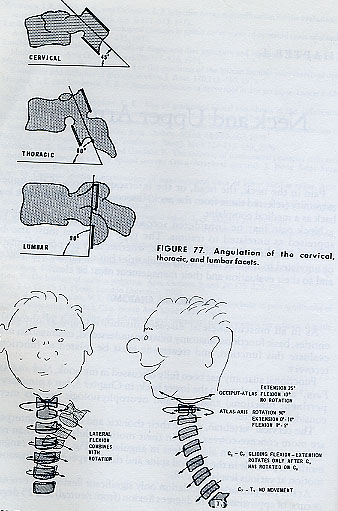
Anatomy/pathology
Alignment

The neck is much more mobile than the low back and is related functionally to vision and hearing. It is also subject to whiplash injuries even when there is just a sudden stop and not a crash.
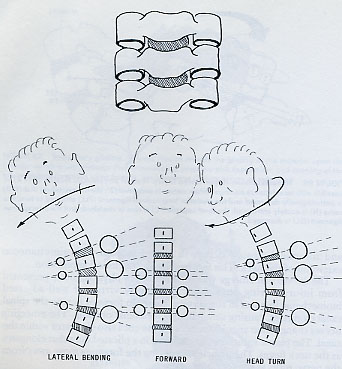
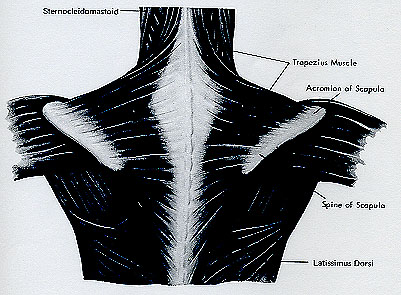
The biggest problem with the neck is a forward head with a tightening and weakening of the spinal extensors.
Don't turn your shoulders into earrings. Let them float down your back as you lengthen your neck like a giraffe. Feel your ears expanding sideways and the top of your head floating through the ceiling.
Headaches can be caused by radiating nerve pain, due to cervical spondylosis, vascular pain, or more serious intracranial problems inside the brain. Always consult a neurosurgeon first to rule out the serious issues, then get an MRI of your neck, and finally learn to relax and realign your spine for better function and mobility.
When your neck is in pain or out of alignment, it will affect your entire spine and can cause trouble in your lower back.
Neck Protocol
Correct alignment, extensor strengthening, pigeon, isometrics. And ROM. Subtle exercises.
Posture check against wall
Look right and left
Seesaw neck
Shoulder shrugs
Stretch neck and shoulders but NOT if you have cervical radiculopathy! 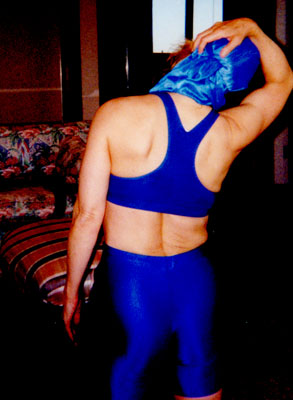
Make g entle, soft arm movements to the side, front and back without moving neck
As you move away from the wall, lead with your chest, not your head.
Review sleeping posture on back with horseshoe or on side with pillow but without too much forward flexion
Pigeon off table or bed to strengthen extensors
Lie on back for single or double thigh flexions and keep head resting on floor.
When your arm is so weak you can't move it then it may be time for surgery or if you have just been in a devastating accident. However, neck surgery is a very risky business. So are high velocity chiropractic adjustments in this area. The neck is a delicate seesaw. Lengthen it like Alice in Wonderland.
If you have a rounded shoulder posture with shortening of your pecs and neck extensors, you may be prone to neurovascular compression. Neck flexors should be strengthened eventually by lifting chin towards chest in a back-lying position.
Ideokinesis
Head as a helium balloon. Eyes in the back of the head. Features of the face melting like hot wax. Drool to relax jaw. Cashmere turtleneck. Diamond necklace.
Activities
Continue normal activities with attention to good posture. Avoid rapid turns and twists like ballet pirouettes or ball sports until pain-free with excellent strength.
Massage
Deep massage of the neck and shoulders feels so good, especially with some traction to lengthen the spine.
Anatomy/pathology 
Posture
Rounded Shoulders
We saw how rounded shoulders and a forward head can cause neck pain but they can also give you shoulder bursitis, tendonitis, or impingement
Humeral and Scapular Stabilizers
Gleno-humeral Rhythm
To avoid impingement, learn to depress the shoulder girdle and rotate the shoulders down as you lift the arms overhead, smoothly the way a ballet dancer does with a port du bras.
Correct, Don’t Clobber the Cuffs
Rotator Cuff Anatomy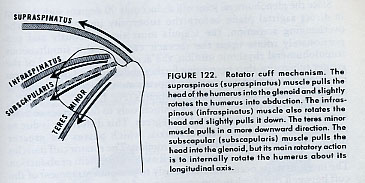
You have four rotator muscles--the infraspinatus and teres minor that turn out the joint, the subscapularis that turns it in, and the supraspinatus that stabilizes it in the joint. If you are prone to dislocation, strengthening the supraspinatus is crucial. Usually the internal rotators are stronger than the external ones, especially if you have rounded shoulders, a hunchback, or forward head. A weak supraspinatus can cause impingement when the arms are elevated overhead.
Rotator Cuff Tears, Strains and Sprains
Shortening or spasm of the teres minor and the infraspinatus will pull the head of the humerus in external rotationa, rubbing the front of the shoulder joint, which could eventually injure the long head of the biceps. This is why you need to strengthen the supraspinatus and subscapularis as well, to stretch the rotators and to stabilize your shoulder girdle.
Rotator Cuff Exercises
The infraspinatus is best isolated in side-lying position. With the elbow glued to the rib cage, lift your hand to the ceiling and back to the floor, turning the shoulder in and out.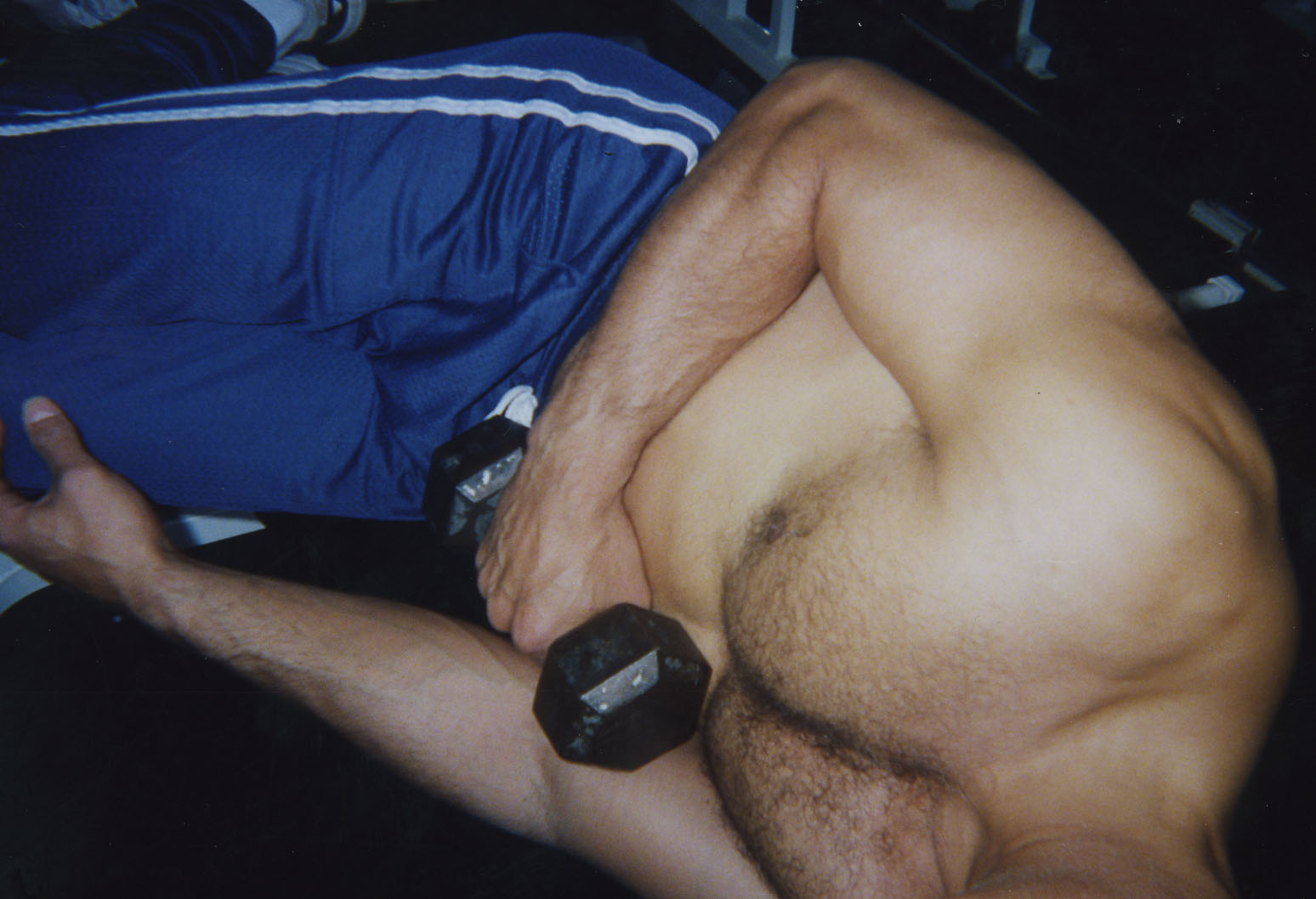
Isolate the supraspinatus by lifting your straight arm up and down in side-lying as if you were doing a lateral raise, beginning with the hand on the thigh and stopping at a 45 degree angle. Hold it there for ten seconds and lower it to your thigh.
Do standing rotator exercises with the band attached to a doorknob, turning in or out to target external or internal rotation. This will strengthen at the end range.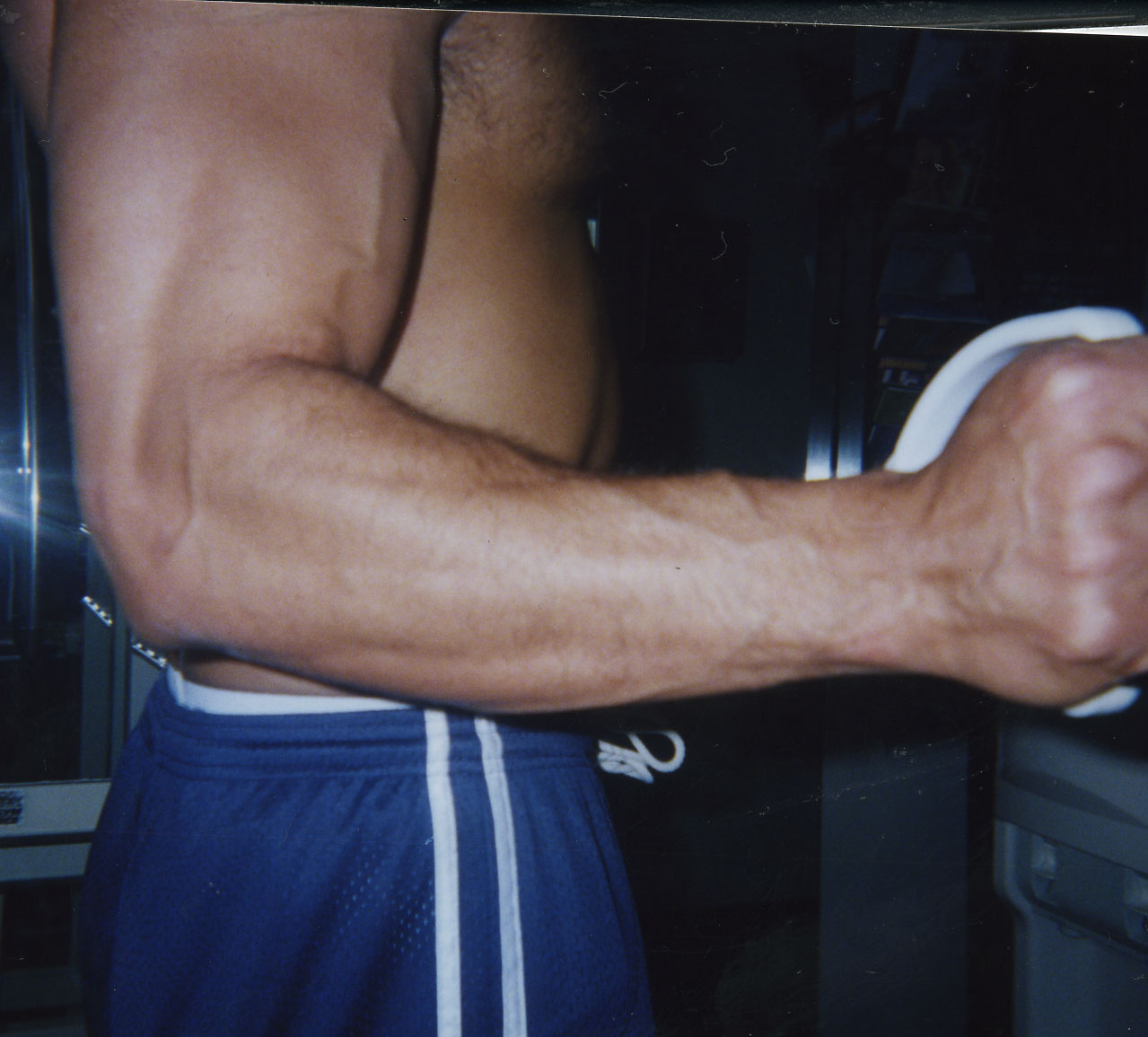
Use the lat pulldown band to stretch your shoulders.
Do lateral raises turning in and out to coordinate the middle deltoid and the rotators.
Lie on a bench with your arms dangling off. Bend the elbows at 90 degrees and turn in and out like a scarecrow. This targets the teres minor, especially if you press your shoulder blades down. In this position you could also strengthen your posterior deltoid, lower trapezius, and rhomboids.
The rotators are strengthened functionally in conjunction with the deltoids in the scarecrow and seat belt exercises but don't do these until you are pain-free and your posture is good.
Eventually you can pull the band down from diagonal right to lower left, a rotation used in sports, as well as pull it up from the floor in the opposite direction.
Dazzling Deltoids
Because of differences in shoulder anatomy, not everyone has the same pain-free range lifting the arms. When in doubt, only do raises to 90 degrees.
Front
In a standing position lift your straight arms forward. Vary the angle by doing reps with your palms facing each other, your palms down, or your palms up. If the weight is light enough you can bring the arms all the way to the ceiling, particularly when the palms are facing each other, a move you can later do with the Speedball. Lying dumbbell press target the anterior deltoid as well as the pecs if it is too difficult to raise your arms forward. Do them one at a time.
Side
Start with the arms hanging by the sides. Lift out to the side, palms up, palms down, palms facing out and facing in to get different levels of rotation. You can also change the angle by bringing the arms slightly forward.
Upright rows are done by keeping the hands close together and lifting the elbows as high as possible with the shoulders down.
Back
You can do this in your deadlift position if your back is strong or lying on a bench with your arms dangling off. Bring your straight arms towards the ceiling in a t-position.
Lift the arms overhead while lying prone. This targets the lower trapezius as well as the rear deltoid muscles.
Taut Traps
Overhead Presses
This exercise can be done sitting or standing. Always do it without weights first, then with light weights. Don’t proceed to heavy weights until you are completely pain-free for six weeks.
Overhead Pull-Ups and Pull-Downs
Shoulder Shrugs
These exercises strengthen the upper trapezius and levator scapulae. But don't go overboard with these exercises if your lats are still weak and you are having impingement problems.
The Missing Link-Lower trapezius
Exercise Sequences: Work backwards. First only resistance is rotation.Climb the wall. Pendulum stretch.
The Pendulum
The best stretch is to bend over, dangling a weight from your hand as you let gravity have your arm, swinging side to side in a pendular motion or drawing figure-8 movements.
Sudden impact, overuse in ball sports, muscle imbalance overhead lift. Unless you rip a muscle playing sports or have an accident, most shoulder injuries or dysfunction are caused by some kind of rotator cuff problem. I can’t stress enough how important it is to strengthen the cuff with bands and weights in every position as a prehab exercise.
Sequences
Don’t forget isometric scapular depressors in shoulder rehab with arm overhead on wall or holding band. Perhaps say Start Progression Finish. Turn in and out for hips and shoulders can be done on almost any exercise for more muscular recruitment. Diagrams of scapulohumeral rhythm are necessary. Don’t forge pendular exercises with iron, holding on to table, keeping torso at right angles to legs, adding traction to shoulder capsule. Move forward and backwards, side to side and then in a circle. Full overhead elevation requires little or no deltoid support if the scapula has fully rotated.
Strengthen your deltoids muscles completely before doing arm elevation with weights because substitution with the trapezius is common.
Stretch pectoral, rotators, climb the wall, static stretch with isometric scapular depressors
Strengthen retractors lying over bench
Strengthen supraspinatus to 15 degrees
Lateral raises
Biceps and triceps
Scapular depressors with band
Scarecrow rotation and seat belts with weights
Overhead press (Once you are pain-free, strong, and fit, you usally BEGIN body building with these big muscles.)
Stretches 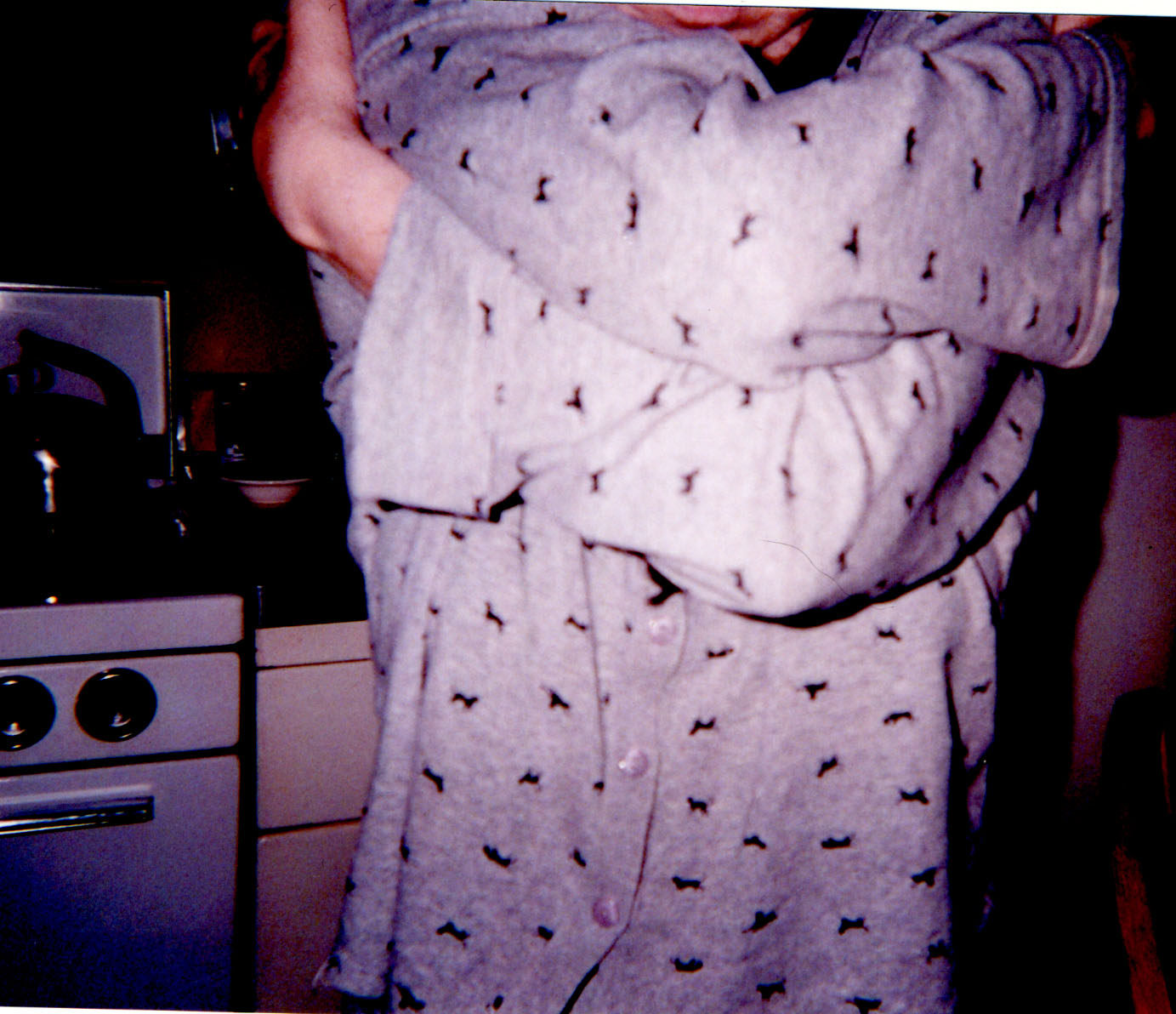 Stretch your middle back by hugging yourself.
Stretch your middle back by hugging yourself.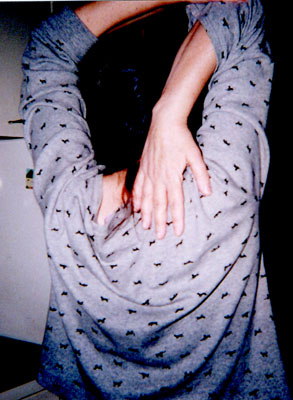 Stretch your triceps by touching the palm of your hand to the back of your shoulder blade and grabbing the elbow with the opposite hand. Lean to the left side to increase the stretch and get the back as well.
Stretch your triceps by touching the palm of your hand to the back of your shoulder blade and grabbing the elbow with the opposite hand. Lean to the left side to increase the stretch and get the back as well.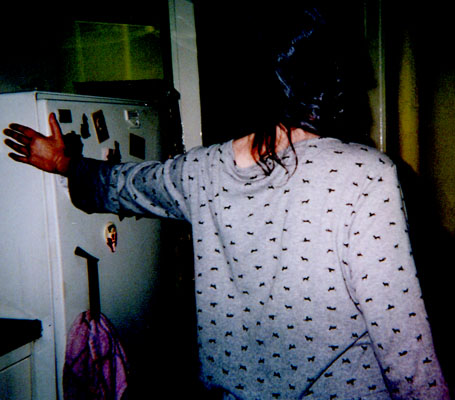 Stretch your pecs by placing your hand on the wall and turning away from it. Keep your shoulders down and even.
Stretch your pecs by placing your hand on the wall and turning away from it. Keep your shoulders down and even.
Ideokinesis
Imagine headlights shining from your collarbones and your shoulder girdle as a soft, velvet cape. Feel the shoulder blades pulling together and sliding down your back like barges on a stream.
Activities
Swimming: Avoid racing crawl and butterfly until the shoulder girdle is balanced and the lats are as strong as the lifters.
Hold off on ball sports until you can lift substantial weights in all positions without pain, and have analyzed your technique to correct any biomechanical errors.
Massage
Deep tissue and trigger point massage works well in side-lying where you can get in behind the shoulder blades to the subscapularis, rotate the blades, stretch the neck and work the entire area.
Ch13: Elbows
Anatomy/pathology 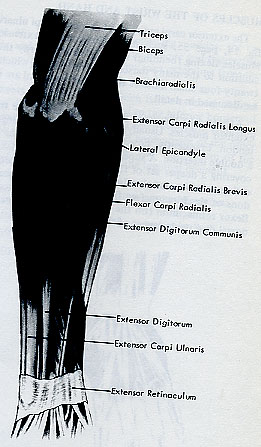
Alignment
The elbow, like the knee, is a modified hinge joint, except that it is used so often to pronate and supinate. This means that the muscles must be strong and balanced.
Epicondylitis: Tennis Elbow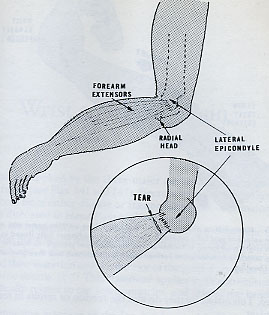
Some of the causes of tennis elbow or late strokes and wristy impacts, both often do to weakness as well as faulty technique.
You can mitigate problems with the two-handed backhand, proper racquet selection and grip size. Stiffer graphite-type racquets with large heads that expand the impact area are better; use string tension at the lowest recommendation. The best way to choose grip size is to measure the distance from the crease of your palm to the tip of your ring finger. You can also play with tennis elbow supports. Your best grip position is the handshake grip with the racquet making an L with the forearm.
Exercises
I have treated so many tennis elbows that take longer than they should to heal because people get bored doing all the different angles of wrist curls, reverse curls, elbow curls, extensions, supination and pronation. Because these are not "cosmetic" exercises like sit-ups, push-ups and butt blasters, you may think you are wasting your time. But to strengthen the arms for sports, writing, gardening, massage, you need to exercise all these angles, particularly the extensors. Since you don't need a cardio warm-up for this, do it while watching TV or sitting on the toilet--slowly, smoothly and patiently.
Tricep extensions, kickbacks, overhead and pull down the dynaband. Wait for dips, chin-ups and push-ups.
Bicep curls in all 3 positions.
Pronate and supinate elbow very slowly--turning your palm up and down, keeping the elbow still.
Ideokinesis
Activities
Don't jump back into tennis before you are healed and stronger than before! Daily life uses these muscles more than enough.
Massage  Mechanotherapy after massage is important.
Mechanotherapy after massage is important.
Ch14: Hands
Anatomy/pathology  These are the dermatomes of the Radial, Ulnar, and Median nerves to help you identify pain pathways.
These are the dermatomes of the Radial, Ulnar, and Median nerves to help you identify pain pathways.
Alignment
Just as the pelvis requires a neutral position even though you may move in and out of it to dance or have sex, so do your wrists. When typing, sleeping, weight lifting, or holding equipment, keep your forearms and the tops of your hands in the same parallel line.
If you can’t maintain good alignment of your wrists at the computer wear carpal tunnel splints. I just finished writing a 327,000 word book before this one, and believe me, I needed those splints for my weekly writing marathons.
Grips
Power grip is the strongest grip, the one you need to hold a hammer, climb a rope, or rock climb.
Precision grip is used for delicate, subtle movements like writing, eye surgery, 1or needlepoint.
Hook grip is used when performing chin-ups or holding the barbell; sweaty hands can interfere with this grip.
Grip and let go: If you hold on all day, you will just get tendonitis.
Trigger Thumb and Fingers
You wake up in the middle of the night and it feels like your thumb or fingers are constantly pulling the imaginary trigger of a gun, only there is no gun, and you didn't tell them to wake you up. You have inflammation of the flexor retinaculum, probably with nodules and you need rest, splints, eventual exercise, and hopefully not surgery.
Carpal Tunnel Syndrome
You wake up in the middle of the night and your hand has gone to sleep or is tingling so badly you wish it would.
Heberden’s Nodes and Arthritis
Arthritis finds all kinds of insidious ways of destroying the hands, with trigger thumb and fingers, carpal tunnel syndrome, bony nodules over your knuckles, calcium deposits, and other inappropriate break-downs or build-ups that interfere with optimal functioning. Try to nip this in the bud with rest, splinting, alignment, and exercise, and only do surgery as a last resort.
Exercises
Rock climbers have the best forearm strength. There are many sophisticated products on the market to improve grip such as the Power Web Comb for $39.95-a rubber mesh web that targets the tops of the arms as well. Insert fingertips into the hole and then spread the fingers to work the extensor muscles. There is also a Dyna-Flex Powerball with a meter. When wound in small circles, the gyroscope in this device spins quickly, creating resistance that forces the user to grip tightly.
Performance: Vary the rhythm of your squeeze from short quick bursts to long holds.Make sure you strengthen your opening as much as your closing.
For years I ignored wrist curls and hand exercises, although I did bicep and tricep curls. I felt that the hands could take care of themselves. Then when I got trigger thumbs and carpal tunnel syndrome, I realized my mistake. I leave a hand squeezer and a strong elastic by the toilet so I will remember to use them everyday and I finish every weight workout with wrist curls in all positions. In the day of computers, it is crucial to strengthen the wrist, hands and fingers as meticulously as the other body parts. Do 12 reps of each on each hand, opening and closing.
Drape your arms over your thighs or the end of a table to focus these muscles.
Let the weights pull the hands, palms facing the floor.
Lift your knuckes up to the ceiling.
Finger Abduction/Extension
Finger Flexion
Do slow reps, static reps and even fast reps because we use our hands in so many ways.
Squeeze silly putty between fingers in opposition. Washing clothes by hand in warm water is also good as long as you don’t overdo it.
Strengthen finger extensors with an elastic band.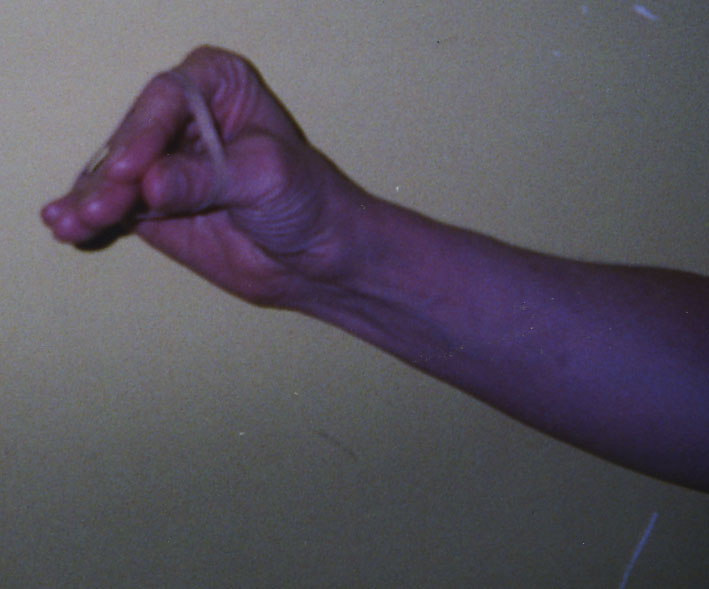
 Leave the elastic band by the toilet so you do it often.
Leave the elastic band by the toilet so you do it often.
Webbed gloves can be used for pool exercises to strengthen the hands.
Grip exercises
I leave this squeezer by the toilet.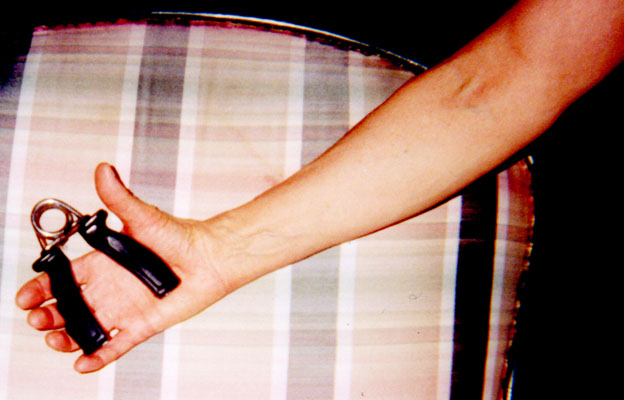 so I do it many times a day.
so I do it many times a day.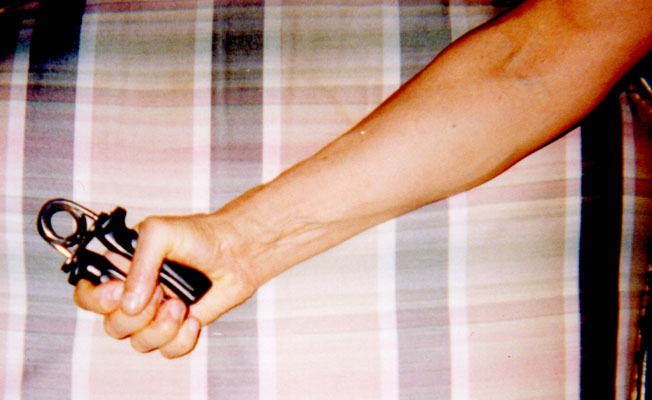
Wrist curls all angles using weights.
Ideokinesis
Activities
When I got trigger thumbs and carpal tunnel syndrome from Lyme disease and overuse, I had to give up my massage practice for several years. Know when to rest and recover. It's hard to live without your hands.
Massage
You can self-massage your hands. Using silly putty or doing laundry by hand in warm water or actually giving a massage is also a massage for your hands. I find that the hands get enough exercise so I rest, stretch, and splint them in my spare time or while sleeping. 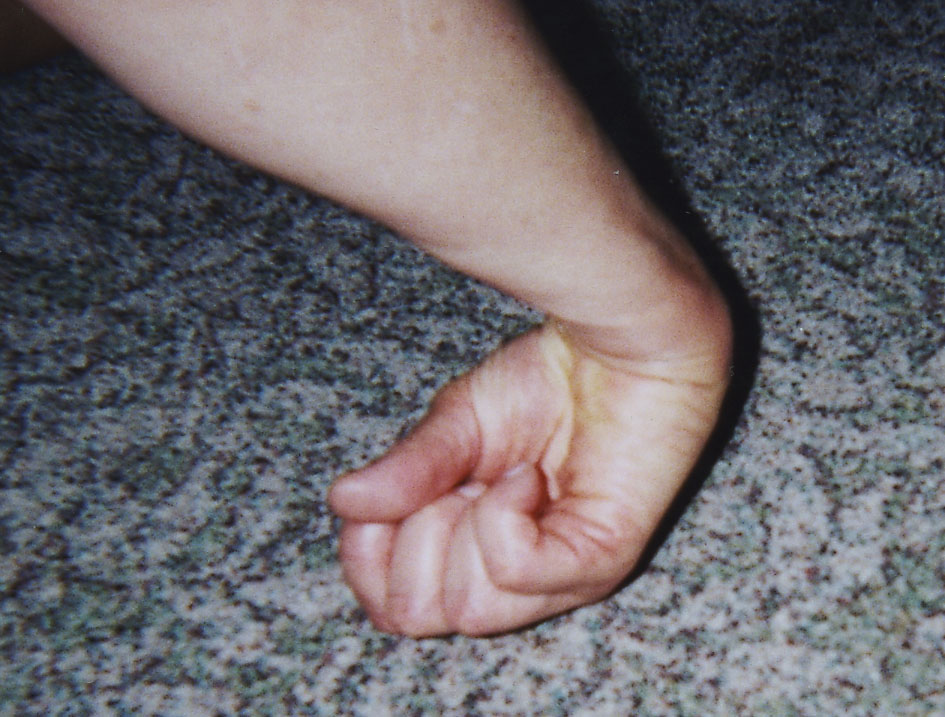
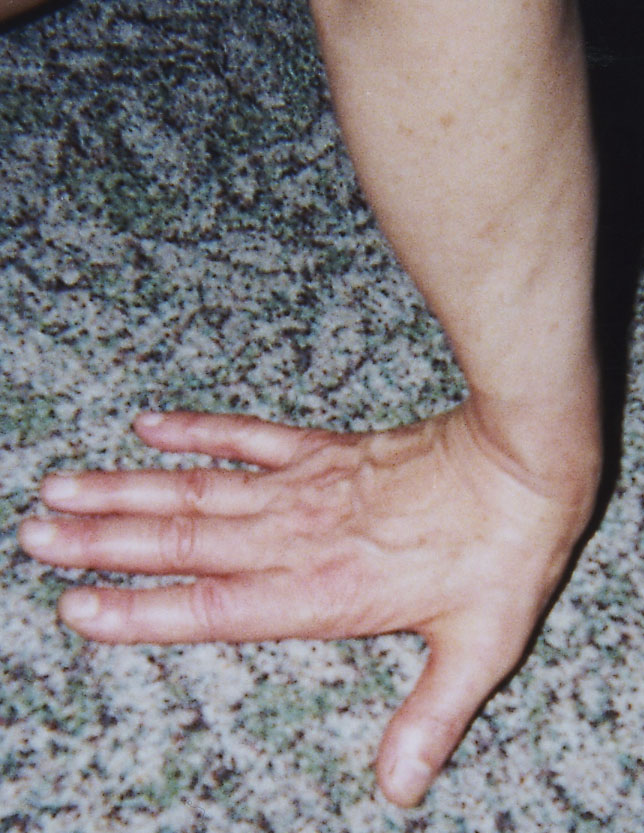
Before going to Periodization for Performance , you might want to ground yourself with real life aerobics and EvergreenEnergy in Evergreen Fitness for the Four Seasons , or get into great cardio-strength shape at home with Evergreen's Knockout Workouts.